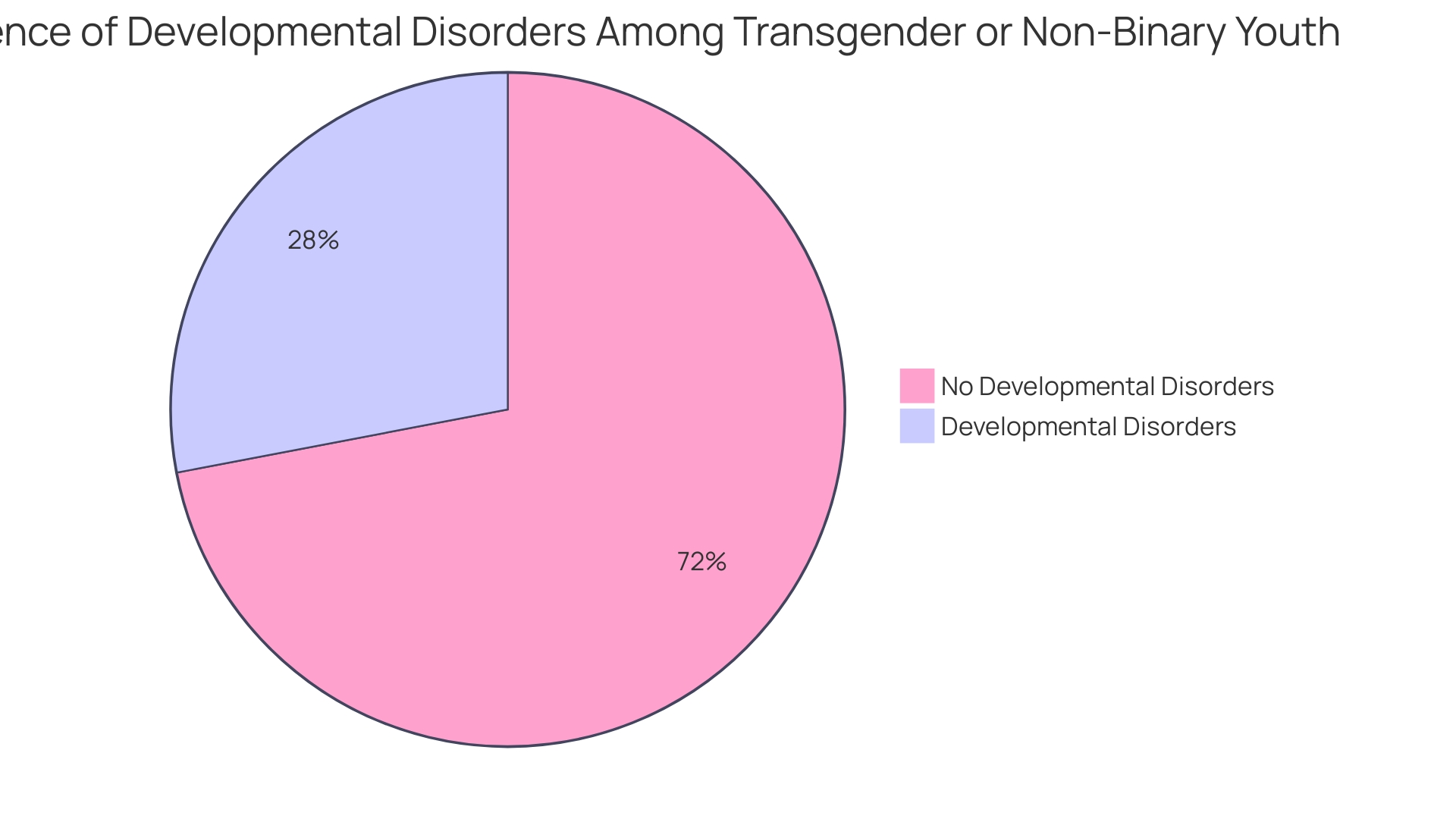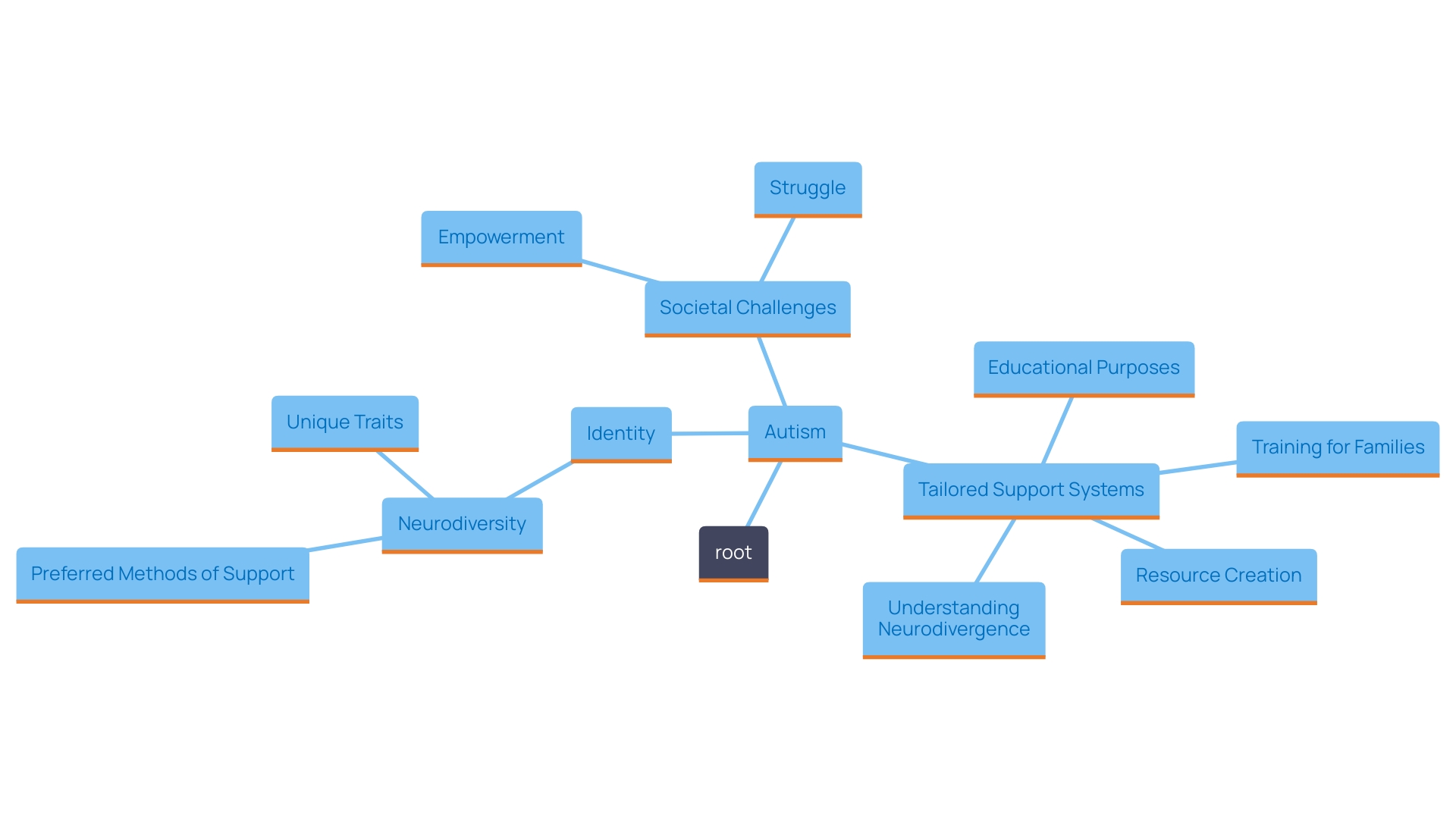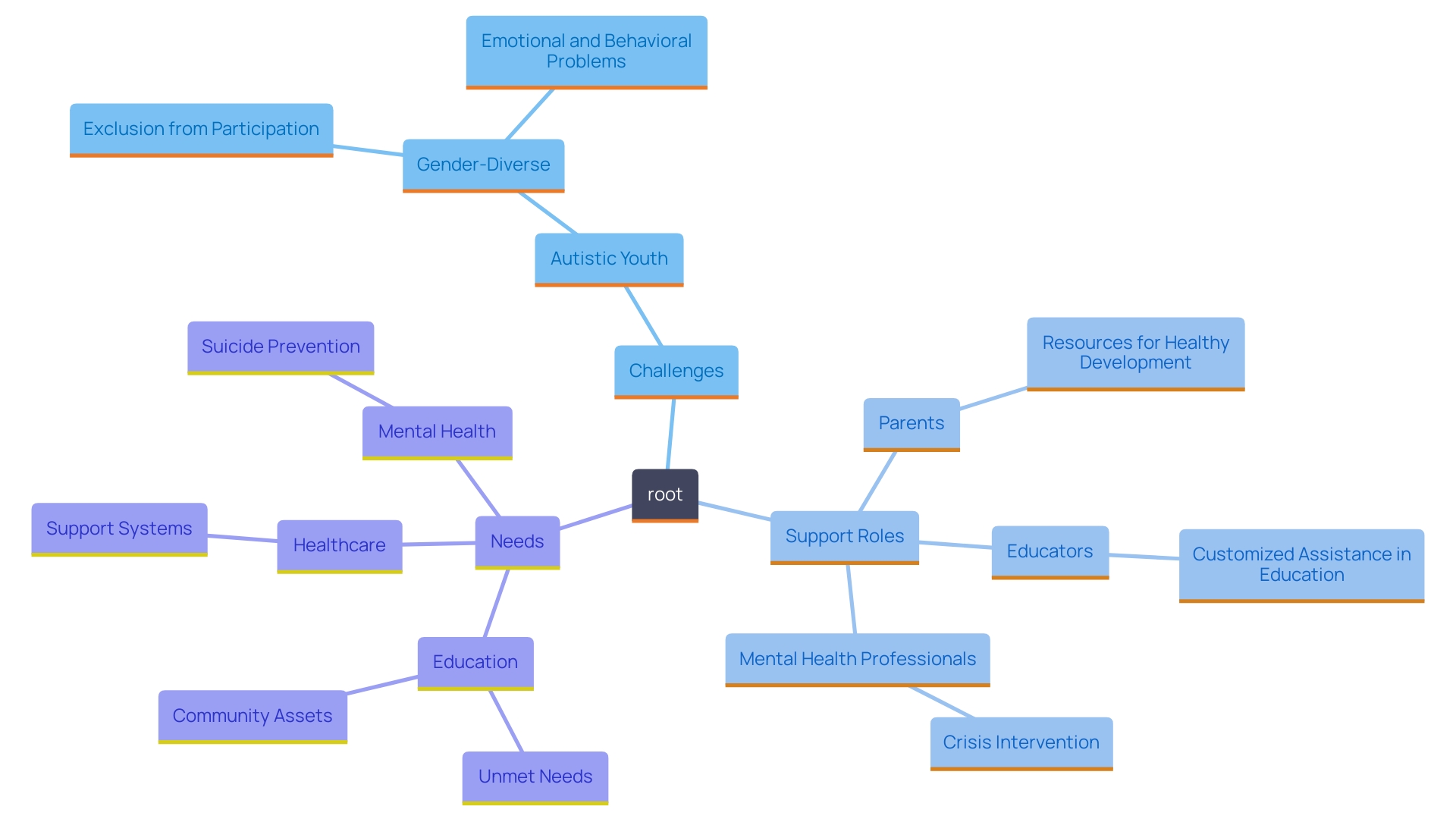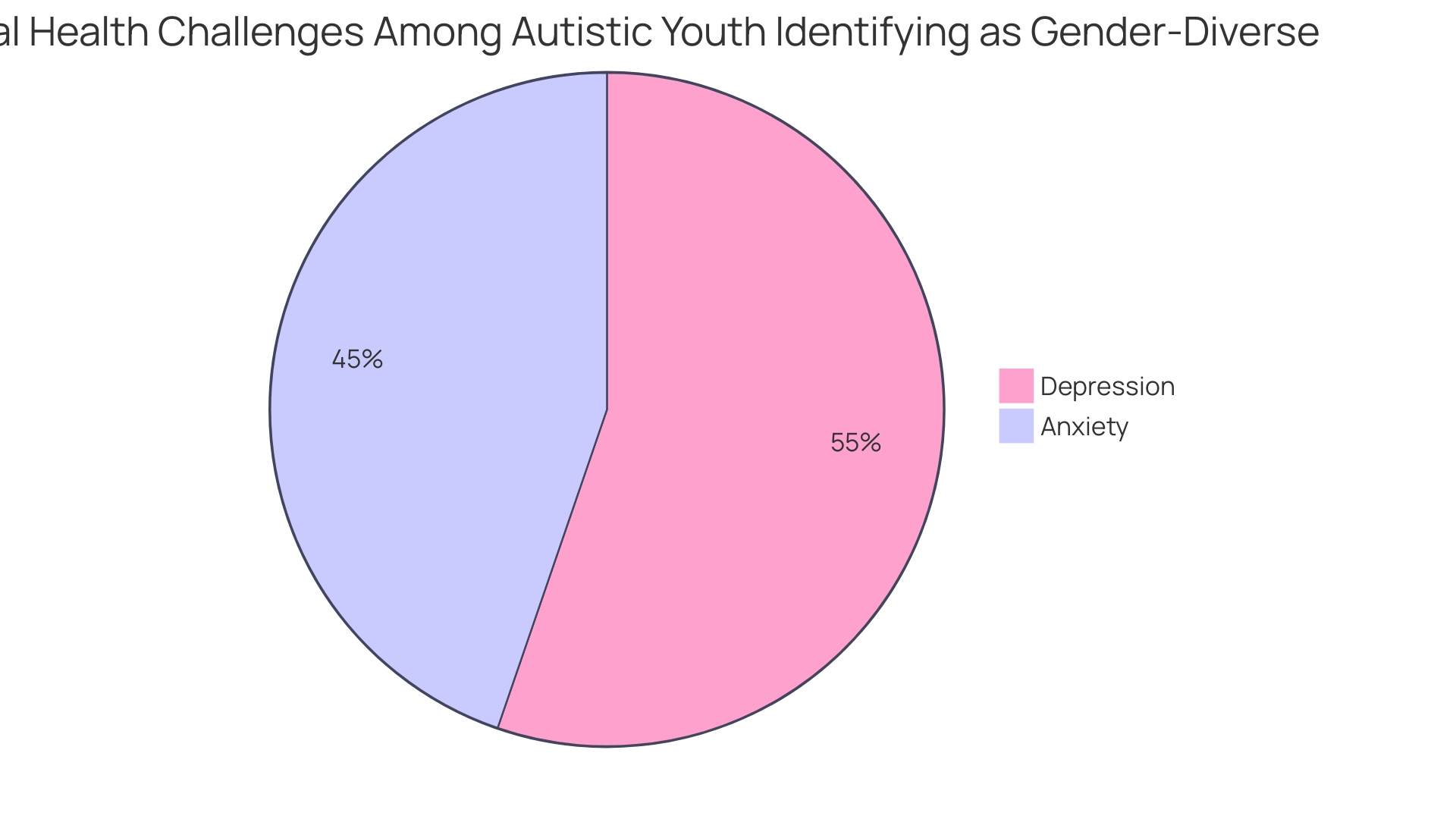Introduction
Navigating the complexities of identity is a journey filled with unique challenges, especially for individuals who find themselves at the intersection of autism and gender diversity. Recent research highlights a striking prevalence of autism among gender-diverse youth, suggesting a critical need for tailored resources and support systems that address their distinct experiences. The intertwined nature of autism spectrum conditions and gender identity reveals not only a higher incidence of autism among those who identify as transgender or non-binary but also underscores the necessity of understanding these identities through the lens of neurodiversity and intersectionality.
With mental health concerns escalated by societal stigma and discrimination, it is imperative to foster environments that validate and empower these individuals. This article delves into the multifaceted experiences of autistic gender-diverse youth, exploring the challenges they face in diagnosis, support, and mental health, while advocating for inclusive practices that recognize their unique contributions and needs.
Prevalence of Autism in Gender-Diverse Individuals
Research has increasingly revealed a significant prevalence of developmental disorders among gender-diverse individuals, indicating that this group experiences spectrum conditions at a higher rate than the general population. For instance, studies estimate that 6% to 28% of youth identifying as transgender or non-binary may also meet the criteria for a developmental disorder. This interconnectedness emphasizes the need for specialized knowledge and resources designed for both the neurodiversity and sexual diversity communities.
Emerging evidence from health service audits suggests that the intersection of neurodevelopmental disorders and identity issues is not just an isolated phenomenon. A 2019 review at the National Gender Service discovered that 10% of people seeking initial assessments had a pre-existing diagnosis of a developmental disorder, with an additional 24% showing clinical characteristics of the condition. Alarmingly, current data indicates that this figure has risen to over 50%, highlighting a growing recognition of the connection between autism and gender.
The unique experiences of autistic people, particularly those assigned female at birth (AFAB), necessitate tailored support in various domains, including education, personal development, and healthcare. 'Autism is increasingly understood through the lens of neurodiversity, recognizing that autistic people navigate both social challenges—such as misunderstanding and stigma—and personal cognitive characteristics.'. This approach emphasizes the importance of viewing this condition not merely as a clinical diagnosis but as an integral aspect of identity for many.
Furthermore, the concept of intersectionality plays a crucial role in understanding the complex social dynamics that affect autistic AFAB people. Social determinants, biases held by clinicians, and the complexities of developmental conditions can all influence the acknowledgment and assistance these people receive. By acknowledging these factors, we can promote a more inclusive approach to research and intervention strategies.
As we proceed to examine the overlap of neurodiversity and identity, it is crucial to promote fair access to resources and assistance for individuals navigating these experiences. The higher rates of mental health conditions among gender-diverse populations further underscore the urgent need for comprehensive, tailored services that address their unique challenges and ensure their well-being.

Overlap Between Autism and Gender Diversity
The intersection of autism and diversity in identity brings forth a unique landscape of challenges and experiences that require careful consideration. Numerous autistic people, especially those designated female at birth (AFAB), frequently explore non-traditional roles or expressions, influenced by their unique cognitive processing and social comprehension. This journey can manifest in both confusion and empowerment. For some, the clarity found in their identity can be liberating, while others may encounter societal rejection and personal struggles with self-identity.
Research emphasizes that individuals on the spectrum often encounter misunderstanding and stigma, which can intensify feelings of isolation. In fact, a significant study revealed that approximately 34% of individuals seeking evaluation at a national service had either a pre-existing diagnosis of a spectrum disorder or displayed clear characteristics of such a condition during assessment. This figure has reportedly increased to over 50%, highlighting the critical need for customized support systems that address both developmental disorders and gender.
The idea of neurodiversity is essential in this context, seeing autism not just as a clinical diagnosis but as a fundamental aspect of a person's self. This perspective shifts the focus from traditional functioning labels to a more inclusive understanding of support needs. Autistic AFAB persons particularly benefit from specialized support in education, identity development, health care, and fostering a sense of belonging in social and professional environments.
Using appropriate terminology is essential in this discourse. 'It is important to distinguish between biological attributes categorized as sex and the psychological, sociocultural, and contextual attributes associated with social identity.'. The terminology used in conversations about neurodevelopmental conditions and identity must represent the lived experiences of people, encouraging the idea that identity classifications that capture the truths of transgender experiences are more cognitively natural than strict, sex-based definitions.
In conclusion, as we explore further into the overlap of autism and sex roles, we must acknowledge the varied experiences and support requirements of people traversing this intricate landscape. By nurturing a welcoming atmosphere that affirms and assists these characteristics, we can enable autistic people to accept their genuine selves.

Challenges in Diagnosing and Supporting Autistic Gender-Diverse Youth
Diagnosing and supporting youth who are both autistic and gender-diverse presents unique challenges for clinicians. Misunderstandings related to sex roles can lead to misdiagnoses or inadequate support, worsening the challenges encountered by these people. The complexities of social communication inherent in autism can further complicate discussions about gender, necessitating that healthcare providers foster a trusting and understanding environment.
A collaborative approach is essential, bringing together parents, educators, and mental health professionals to ensure comprehensive care. This teamwork acknowledges the diverse needs of autistic youth, especially those who identify as transgender or non-binary. 'Autistic people assigned female at birth (AFAB) may need customized assistance in education, personal development, healthcare, and fostering a sense of belonging within social and professional settings.'.
Emerging research highlights that autistic people often face higher rates of mental health issues, including depression and anxiety, compared to their neurotypical peers. This is particularly true for those with co-occurring emotional and behavioral problems, who are at an increased risk of exclusion from meaningful daily social participation in their communities. Providing adequate resources to caregivers is vital, as they play a crucial role in supporting their children’s healthy development and well-being.
As Dr. David (Dan) R. Offord, a respected child psychiatrist, poignantly stated, “Growing up in Canada is like a race. 'I am indifferent if my kids participate in a competition as long as it is just.' This feeling highlights the necessity for fair support structures that tackle both the unmet requirements and the distinct contributions of children with disabilities, including those experiencing the intersections of neurodiversity and personal development. Addressing these challenges with compassion and respect is essential for fostering an inclusive environment conducive to the growth and well-being of all youth.

Mental Health Impacts and Minority Stress
Autistic youth who identify as gender-diverse often face elevated levels of minority stress, primarily driven by societal stigma and discrimination. This stress can lead to significant mental health challenges, such as anxiety and depression. Recent studies indicate that depression rates in transgender and nonbinary individuals can reach as high as 84%, while anxiety affects about 68% of this population. These alarming statistics underscore the urgent need for a deeper understanding of the mental health implications for autistic gender-diverse youth.
The overlap of neurodevelopmental differences and gender dysphoria can complicate the formation of self. Autistic self-concept, which can encompass both personal and social dimensions, plays a crucial role in how these youth navigate their experiences. When autism is embraced as a core aspect of one's identity, it can empower people to make choices that align with their strengths and values. However, the societal pressures and potential for marginalization can diminish this sense of empowerment, leading to increased vulnerability.
Creating supportive communities and affirming environments is essential in alleviating these mental health burdens. According to Dr. David (Dan) R. Offord, a child psychiatrist, "Engaged, peaceful, and well-supported participation of children and youth with disabilities in the major school, home, and leisure domains of their lives is a fundamental determinant of mental health." This highlights the importance of recognizing both the unmet needs and the valuable assets that autistic gender-diverse youth bring to their communities. By fostering inclusive practices, we can reduce chronic sources of stress and ensure that these individuals receive the necessary support for their development and well-being.
Access to gender-affirming services remains critically important. Barriers such as inadequate insurance coverage and a lack of trans-competent clinicians can prevent youth from receiving the care they need. Addressing these issues is vital to helping autistic gender-diverse youth not only survive but thrive as authentically engaged members of their communities.

Conclusion
The exploration of the intersection between autism and gender diversity reveals a pressing need for tailored support systems that acknowledge the unique experiences of autistic gender-diverse youth. With a significant prevalence of autism within this population, it is clear that specialized resources are essential to address their distinct challenges and promote well-being. This understanding emphasizes the importance of recognizing autism not merely as a clinical diagnosis but as an integral part of identity, particularly for individuals assigned female at birth.
In navigating the complexities of identity, autistic gender-diverse individuals often face heightened levels of minority stress, exacerbated by societal stigma and discrimination. The alarming rates of mental health issues, including anxiety and depression, highlight the urgency of fostering inclusive environments where these youth can thrive. By promoting supportive communities and equitable access to gender-affirming services, it becomes possible to mitigate the mental health burdens they face.
Collaboration among parents, educators, and mental health professionals is crucial in providing comprehensive care that meets the diverse needs of autistic gender-diverse youth. This collective approach not only empowers these individuals but also ensures that their unique contributions are recognized and valued. In advocating for equitable resources and inclusive practices, society can create a landscape that supports the authentic expression and development of all youth, paving the way for a more understanding and inclusive future.




